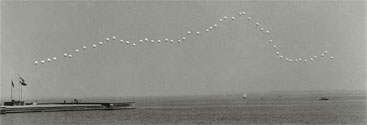
Born in 1938 in Appenzell (CH). Lives and works in Saint-Gallen (CH) / Born in 1942 in Speicher (CH). Lives and works in the United States

1975
series of 7 B&W photographs on Baryta paper
6x(41,5 x 54,5 cm) et 1x (41,5 x 118,5 cm)
Year of Purchase: 2006
Säntis und Bodensee (1975) is a site-specific installation, at once monumental and aerial. Fifty or so large white balloons inflated with hydrogen hang over Lake Constance (in German, Bodensee). Each floats in the air at a meticulously calculated elevation, and their alignment outlines the silhouette of the nearby Säntis Mountain. This celestial drawing is not only the result of the painstaking work of analysis and topographic data collection, planning and calculation, but also of the elaboration of a precise system of ballasting and mooring of the balloons. The ephemeral installation is also documented through photographs and diagrams that show the final result in addition to the preparatory stages. This has little in common, then, with chance, the unforeseen, or slippage, which generally constitute the artist’s trademark. Indeed, Roman Singer’s sculptural and performative approach often relies on instability, free-fall, melting, evaporation, or flow, as well as on projection, explosion, or flight, etc., which threaten the assembled elements . . . and sometimes the artist himself. For that purpose, his favorite props include a host of banal objects: fans and radio controlled helicopters for suspension and flight; boots, bicycles, canoes, skis, and a van for relocating; ramps, rockets, and fireworks for thrust, etc. These objects are put together in unlikely and dangerous devices, halfway between scientific experiments, open-air bricolage, and poetic terrorism. And when a kind of equilibrium appears among objects, it’s only better to hint at an imminent reversal—like a lit candle placed on a gasoline-filled cushion (Kissen mit Kerze, 1983). Happily playing with the elements (water, earth, air, fire) by combining the natural and the artificial, the artist assimilates the implacable consequences of the threat of gravity as well as “weightlessness,” since the outcome is more often closer to farce than to an accident. Further, Signer’s apparently simple way of documenting his actions recovers the foundations of a certain tradition of comedic cinematography, between burlesque and slapstick: the unexpected metamorphosis of a point of view, suspense, expectation, inevitable fall. It tends toward Tex Avery-type of performance: explosive, absurd, and jubilatory.
By contrast, Säntis und Bodensee is rather an essentially graphic work of patience and premeditation. Transposition of a volume and of a contour in an abstract dotted line that delimits the silhouette of an imaginary mountain over the water. This piece represents, not without a dose of humor, a demiurgic act on the scale of the landscape: the willful superposition of two contradictory motifs, one liquid and flat, the other solid and uneven. In a realistic manner, Säntis und Bodensee draws the relief of a mountain made of air, impassable and yet as tempting as a pair of floating skis equipped with inflatable armbands in another of Signer’s pieces (Ski, 2000). Signer’s works incite to dangerous usage whose impracticable character makes one imagine whimsical activities: skiing on water or scaling balloons. Generally practicing a sort of odd-ball, farcical land-art, Säntis und Bodensee seems directly animated by a romantic, or even epic breath. Drawing or heavenly design?
Guillaume Désanges